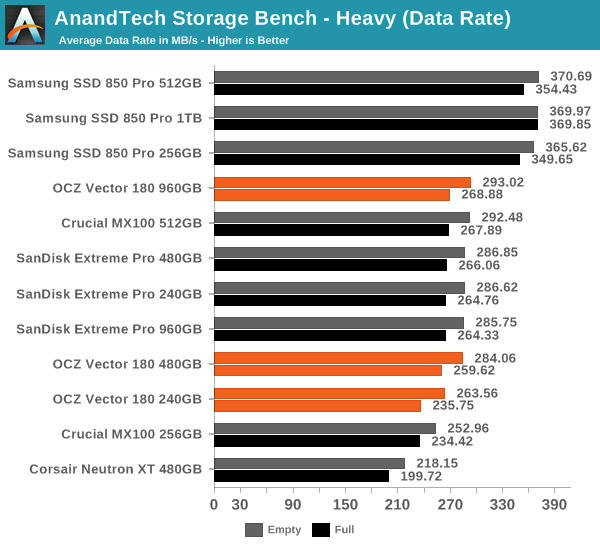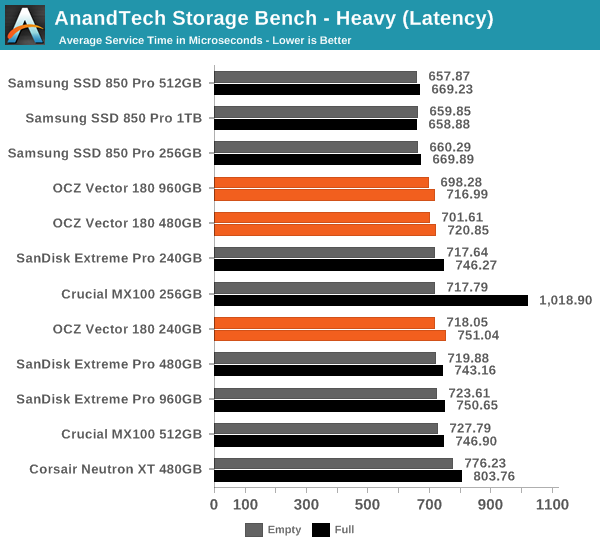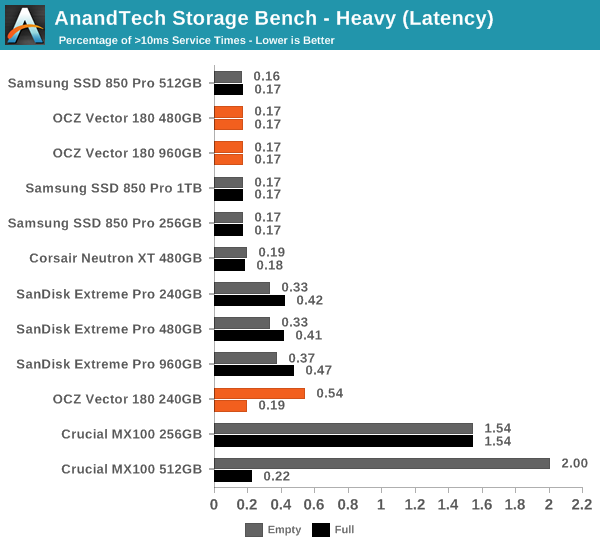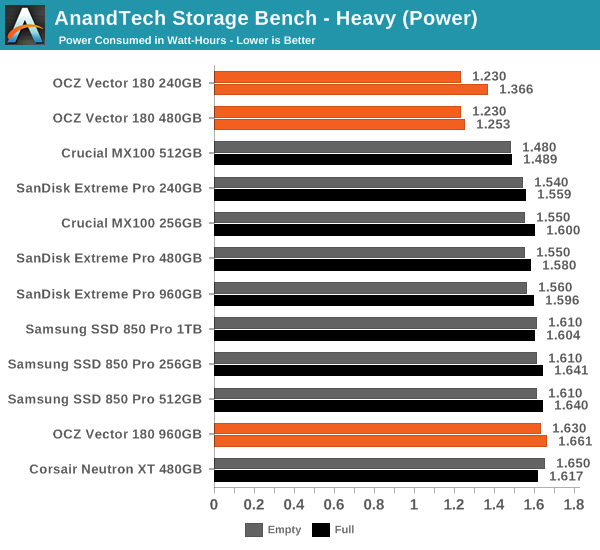The OCZ Vector 180 (240GB, 480GB & 960GB) SSD Review
by Kristian Vättö on March 24, 2015 2:00 PM EST- Posted in
- Storage
- SSDs
- OCZ
- Barefoot 3
- Vector 180
AnandTech Storage Bench - Heavy
While The Destroyer focuses on sustained and worst-case performance by hammering the drive with nearly 1TB worth of writes, the Heavy trace provides a more typical enthusiast and power user workload. By writing less to the drive, the Heavy trace doesn't drive the SSD into steady-state and thus the trace gives us a good idea of peak performance combined with some basic garbage collection routines.
| AnandTech Storage Bench - Heavy | ||||||||||||
| Workload | Description | Applications Used | ||||||||||
| Photo Editing | Import images, edit, export | Adobe Photoshop | ||||||||||
| Gaming | Pllay games, load levels | Starcraft II, World of Warcraft | ||||||||||
| Content Creation | HTML editing | Dreamweaver | ||||||||||
| General Productivity | Browse the web, manage local email, document creation, application install, virus/malware scan | Chrome, IE10, Outlook, Windows 8, AxCrypt, uTorrent, AdAware | ||||||||||
| Application Development | Compile Chromium | Visual Studio 2008 | ||||||||||
The Heavy trace drops virtualization from the equation and goes a bit lighter on photo editing and gaming, making it more relevant to the majority of end-users.
| AnandTech Storage Bench - Heavy - Specs | ||||||||||||
| Reads | 2.17 million | |||||||||||
| Writes | 1.78 million | |||||||||||
| Total IO Operations | 3.99 million | |||||||||||
| Total GB Read | 48.63 GB | |||||||||||
| Total GB Written | 106.32 GB | |||||||||||
| Average Queue Depth | ~4.6 | |||||||||||
| Focus | Peak IO, basic GC routines | |||||||||||
The Heavy trace is actually more write-centric than The Destroyer is. A part of that is explained by the lack of virtualization because operating systems tend to be read-intensive, be that a local or virtual system. The total number of IOs is less than 10% of The Destroyer's IOs, so the Heavy trace is much easier for the drive and doesn't even overwrite the drive once.
| AnandTech Storage Bench - Heavy - IO Breakdown | |||||||||||
| IO Size | <4KB | 4KB | 8KB | 16KB | 32KB | 64KB | 128KB | ||||
| % of Total | 7.8% | 29.2% | 3.5% | 10.3% | 10.8% | 4.1% | 21.7% | ||||
The Heavy trace has more focus on 16KB and 32KB IO sizes, but more than half of the IOs are still either 4KB or 128KB. About 43% of the IOs are sequential with the rest being slightly more full random than pseudo-random.
| AnandTech Storage Bench - Heavy - QD Breakdown | ||||||||||||
| Queue Depth | 1 | 2 | 3 | 4-5 | 6-10 | 11-20 | 21-32 | >32 | ||||
| % of Total | 63.5% | 10.4% | 5.1% | 5.0% | 6.4% | 6.0% | 3.2% | 0.3% | ||||
In terms of queue depths the Heavy trace is even more focused on very low queue depths with three fourths happening at queue depth of one or two.
I'm reporting the same performance metrics as in The Destroyer benchmark, but I'm running the drive in both empty and full states. Some manufacturers tend to focus intensively on peak performance on an empty drive, but in reality the drive will always contain some data. Testing the drive in full state gives us valuable information whether the drive loses performance once it's filled with data.

It sure seems like Samsung is the only manufacturer that has figured out a secret recipe to boost throughput with SATA 6Gbps because all the other drives are hitting a wall at ~290MB/s.

In terms of latency the difference between all drives is much more marginal. The Vector 180 has a small advantage over the Extreme Pro at larger capacities, although once again the 850 Pro tops the charts.

The Vector 180 is also very consistent with only a small number of >10ms IOs. Oddly enough, the 240GB does better when it's full, although I think that might be just an anomaly since it practically makes no sense at all.

Similar to what we saw in The Destroyer benchmark, the 240GB and 480GB Vector 180 has wonderful load power characteristics and the difference to other drives is actually fairly significant.










89 Comments
View All Comments
LB-ID - Thursday, March 26, 2015 - link
Looks like an overpriced product that doesn't stack up against competition in the same price range. Given OCZ's extensive track record of failures and attempts to use their user base as unpaid beta testers I can understand their desire to include a feature to give more peace of mind, but in reality it's just not that useful and certainly insufficient to overcome years of accumulated ill will.serndipity - Thursday, March 26, 2015 - link
The specifications say it all.On a $, performance, reliability, endurance, warranty basis, the OCZ 180 falls significantly short of even the consumer grade competition (e.g. Crucial or Samsung).
Unfortunately, the OCZ story when from deceiving investors, to customers, ending in bankruptcy.
Sadly, the same management etc., remains in place
Be smart and avoid OCZ
ocztosh - Monday, March 30, 2015 - link
Hi LB-ID, thank you for your feedback. We have shipped countless Barefoot 3 based drives across multiple series products and never once had to rev silicon. We have made updates to firmware to continually improve our products. The addition of the PFM+ feature was a decision to support customers that are really on the edge of enthusiast and workstation. This is a required feature for many enterprise drives and we felt there was a value to including this feature into our Vector 180 Series. We agree that not every customer necessarily needs this feature, and for those customers across the client spectrum we have other BF3 based drives that do not include the additional circuitry, but for those customers that really would like that extra layer of protection we were able to integrate this feature without a price premium over our previous Vector 150 Series. We have already received a very positive response from some users but will continue to offer a range of drives to meet the needs of different user applications.voicequal - Friday, March 27, 2015 - link
Wow, great review and a ton of new tests and data. The bathtub curve on the mixed sequential read/write performance will be very interesting to compare to forthcoming NVMe drives. I was surprised by how much the IOPS were reduced by commingling of sequential reads/writes. Seems to be room for improvement in this area.Ethos Evoss - Saturday, March 28, 2015 - link
The worst company of SSD's some OCZ or OWC or PVC .. jeez trash.. it's been sold to toshiba anyway ..ocztosh - Monday, March 30, 2015 - link
Hello Ethos Evoss. We are sorry that you feel this way and/or if you had a negative experience in the past. We are indeed now part of Toshiba and OCZ Storage Solutions is a very different organization as a subsidiary of Toshiba. Toshiba has provided the ability to vastly enhance resources for product development as well as given us complete access to their premium NAND. We certainly will continue to strive to meet the high expectations of you, our valued customers. Thank you again for your input.daerron - Tuesday, May 26, 2015 - link
Nice in depth analysis Anandtech! Read the article as I'm receiving a new Vector 180 240GB drive this week as my original Vector bricked itself earlier this month after around 2 years of service. I have to say that I'm really impressed with OCZ's customer service as I couriered the drive last week and will be receiving a brand new and latest SSD in return this week. Fortunately I had my data backed up as it really just died without any warning. Based on the analysis I was also thinking this would be a killer laptop drive, till I saw the lack of slumber support which is a bit of a disappointment and opportunity missed. Still the PFM+ and low power usage is also most welcome in my workstation PC. We have regular power cuts in my country so its great to have that extra peace of mind.bogdan_kr - Thursday, December 17, 2015 - link
Hello guys. I would like to ask how exactly this Storage Bench - Light is designed. The description says it is designed to be an accurate illustration of basic usage with Total IO Operations 832,339, Total GB Read 17.97 and Total GB Written 23.25.With its 23 GB of writes it should account for roughly two or three days of average usage (i.e. 7-11GB per day).
How long (typically) does it take to finish this bench?
Is it designed to last for few hours (which would account for a typical daily use) or is it designed to finish as fast as possible, in few minutes perhaps?
bogdan_kr - Saturday, January 23, 2016 - link
I am aware that most likely it is a rhetorical question but can anyone from AnandTech answer it, please? I just wanted to be sure about that benchmark.